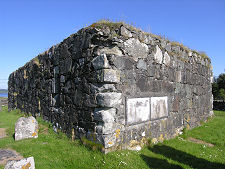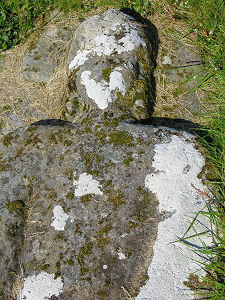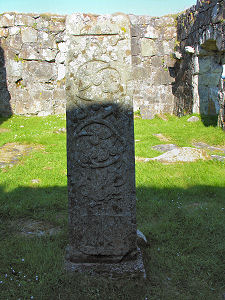 The Churchyard at Pennygown |
Two miles from Salen on the seaward side of the road to Craignure is a graveyard containing the roofless remains of a small single-roomed building. This is Pennygown Chapel, and it stands within Pennygown Churchyard. Most motorists, relieved to be on one of Mull's few stretches of good road, will simply keep on passing by, even if they notice the graveyard, which is plainly in sight from the road. Those who bother to stop and look more closely at the chapel and churchyard will find their time and effort amply repaid.
Pennygown Chapel was probably built in the early 1200s and is said by some to have been one of seven medieval churches serving Mull: though given that the population of the island was far greater in earlier centuries than it is today, the chapel looks rather small to accommodate one-seventh of the inhabitants. Perhaps the only thing that can be said with any certainty about the chapel is that the usual reliable sources are unusually quiet about it, and that what little can be found seems to rely to an unusual extent on legend or supposition.
Having got the disclaimer out of the way, let's move on to what seems to be the more soundly based of the legends surrounding the churchyard ("more soundly based" being used here in the slightly odd sense of it being the story more likely to be a genuine traditional legend). It has long been believed locally that friendly fairies used to live here, and that they would use their magic powers to undertake small magical tasks for people who left requests here. One day someone left a small piece of wood with a request that it be transformed into a ship's mast. The fairies responded by moving out and they have never been seen or heard of since.
Just outside the walls of the chapel lie two remarkable grave slabs. These are to be carved with the effigies of a lord and his lady and are similar in style to grave slabs on show at Kilninian Church on Mull and the Iona Abbey Infirmary Museum on Iona. It is wonderful to see these slabs still in place, covering the graves of those they were placed here to remember (though, of course, this does mean they are subject to continuing erosion).
These grave slabs are more than enough on their own to make the trip to Pennygown worthwhile. Local legend says that they mark the graves of one of the Maclean Chiefs of Duart and his wife. This seems possible, as grave slabs like these were only made for the rich and powerful. Where the story takes a more dubious turn, however, is where it suggests that this particular lord and his lady had been known to dabble in witchcraft, and as a result they were buried outwith holy ground.
This doesn't add up: the graves are close to the chapel, just where you would expect to find them, and most certainly within the consecrated area of the graveyard. And while it is true that some of the Macleans of Duart were not nice people (especially the one who burst in on the celebrations after the wedding of his widowed mother and killed 18 of the wedding guests), the era of witch hunts in Scotland seems to post-date the era of West Highland grave slabs like these.
Entering the roofless chapel brings another surprise, every bit as exciting as finding the grave slabs outside it. Here stands the shaft of a Celtic cross, some 1.3m high. One side is carved with a crucifix, vegetation, a griffin, and a traditional highland galley. The other side carries the carving of the Virgin and Child. It seems pretty obvious that someone has placed the shaft here at some point since the chapel became ruinous: and it is tempting to speculate that the complete cross, which now misses its head, once stood outside the chapel, in much the way that crosses still stand outside Iona Abbey.
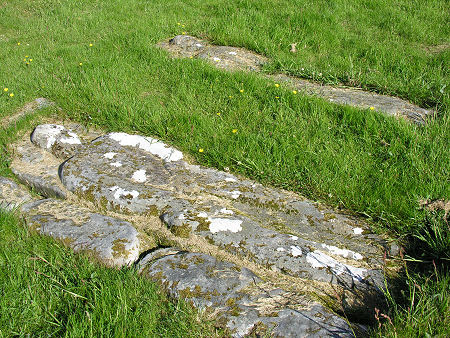 Effigies of a Knight and His Lady |
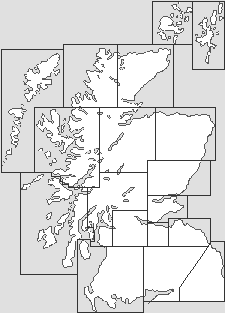
|
|
|
Visitor InformationView Location on MapGrid Ref: NM 604 433 What3Words Location: ///adjust.fingertip.bump |
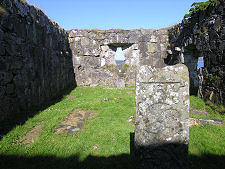 Chapel Interior |
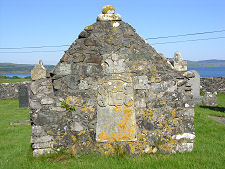 Monument in the Churchyard |
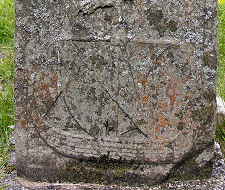 Highland Galley on Cross Shaft |
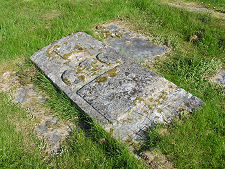 More Old Grave Slabs |
 Gravestone with Carved Chain |
